Menus
- The final on the racetrack in Spain
- Comparison test of superbikes: part 2
- Technical specifications
- Motorland Aragon / Alcaniz
- MOTORCYCLE measurements
- The tires for the test
- MOTORCYCLE test result
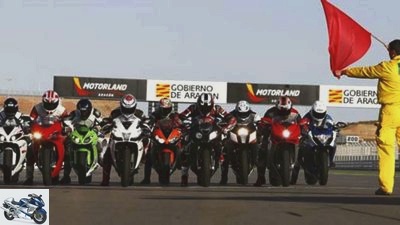
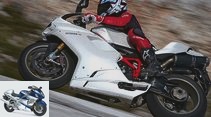
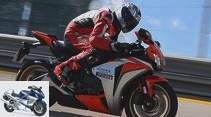
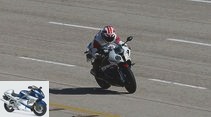
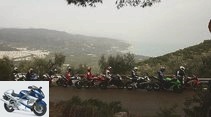
42 photos
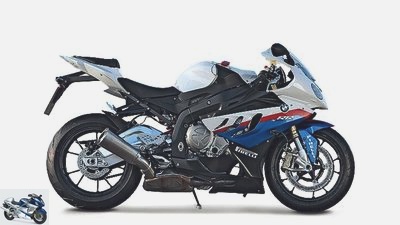
Jahn
1/42
Top handling and transparent feedback are what make the BMW S 1000 RR. It also owes a lot to the electronic tools.

Jahn
2/42
Bike number three: the Ducati 1198 S. It offers racing spirit and the finest equipment, but at a steep price.
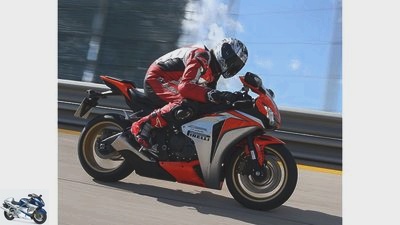
Jahn
3/42
The Honda Fireblade can’t quite keep up in terms of performance, but the stability on the track and its torque can compensate for this shortcoming.
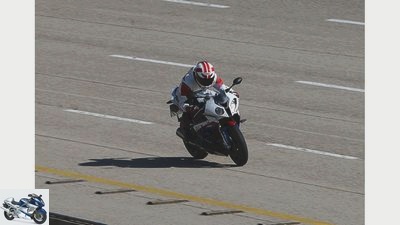
Jahn
4/42
In Nardo, the BMW S 1000 RR was able to beat everyone. On the circuit she showed that her performance advantage pays off.
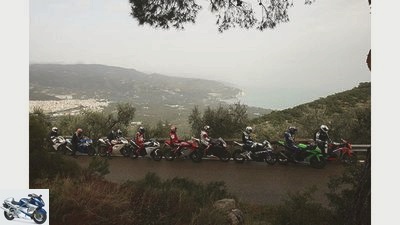
Jahn
5/42
And because of the bad weather, the view remains rather modest.
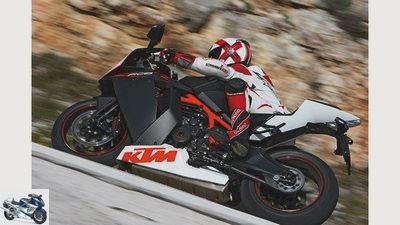
Jahn
6/42
The KTM RC8 R comes in sixth. It impresses with its V2, which can easily take on any four-cylinder.
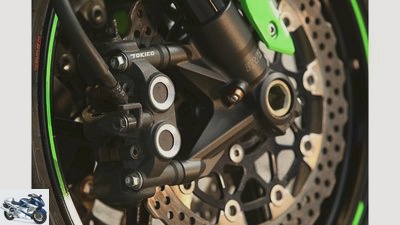
Jahn
7/42
Another highlight of the Kawasaki ZX-10R is its brake. With excellent deceleration values, it can even slow down the BMW S 1000 RR, and that without control electronics.
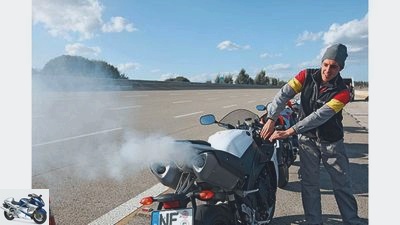
Jahn
8/42
But now it’s smoking. The Yamaha YZF-R1 failed the head gasket. Since the Yamaha has often had problems with overheating, the enormous burden is probably to blame.
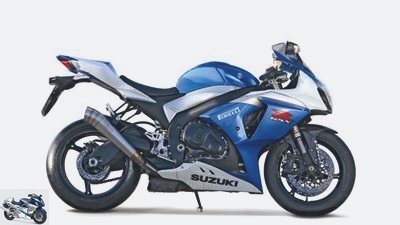
Jahn
9/42
The Suzuki GSX-R 1000: A reputation like Donnerhall, but a little old. Japanese superbike made from old shot and grain.
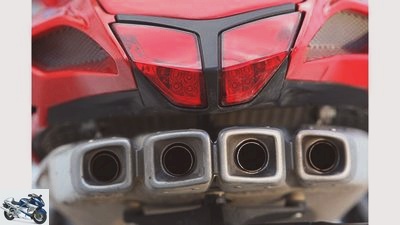
Jahn
10/42
That knocks you out. The brute sound from the pipes of the MV Agusta F4 is unique.
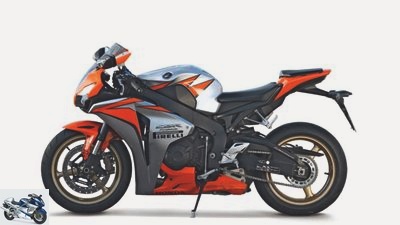
Jahn
11/42
The most noticeable feature of the 2010 generation Fireblade is their new drawing. The rest remained largely unchanged.

Jahn
12/42
One of the noble components of the Ducati 1198 S is the Ohlins shock absorber that gives the Duacti great road holding, but only at high speeds.
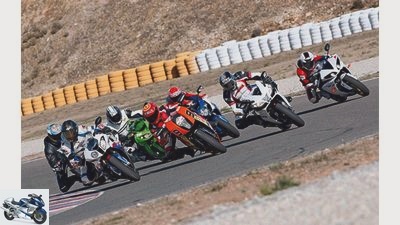
Jahn
13/42
In addition to Nardo, the test on the racetrack in Aragon, Spain, offered the best opportunity to determine the handling and driving characteristics of the bikes.

Jahn
14/42
All nine show that they are super athletes. The BMW, however, has the edge.
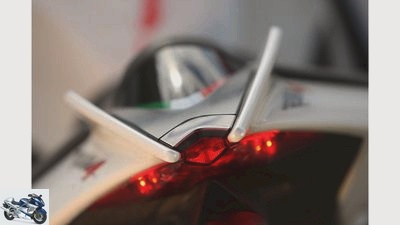
Jahn
15/42
The Aprilia RSV4 R can definitely score with its design. From behind it is reminiscent of the stern of a fighter jet.
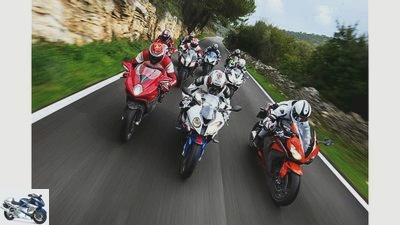
Jahn
16/42
All nine super sports cars: Aprilia RSV4 R, BMW S 1000 RR, Ducati 1198 S, Honda Fireblade, Kawasaki ZX-10R, KTM 1190 RC8 R, MV Agusta F4, Suzuki GSX-R 1000, Yamaha YZF-R1 on the journey through Italy.
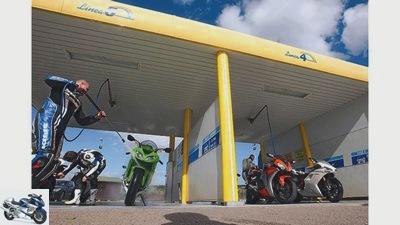
Jahn
17/42
To ensure full functionality, thorough cleaning is always worthwhile.
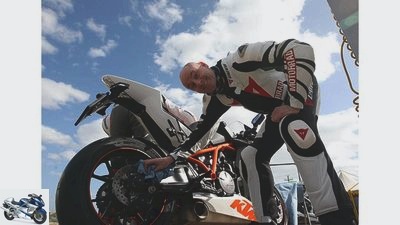
Jahn
18/42
So that the bike looks really good afterwards, a little polishing is carried out.
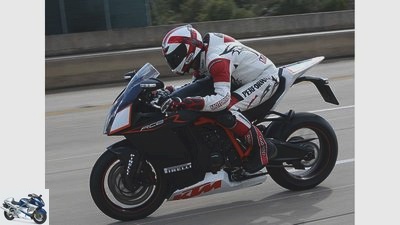
Jahn
19/42
A rolling experiment: the KTM RC8 R with its unique design language. Either you love it – or you don’t like it.
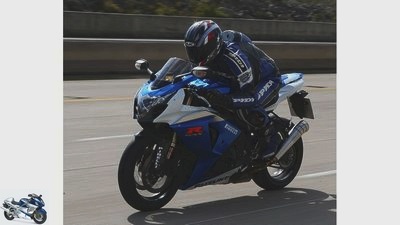
Jahn
20/42
The Suzuki GSX-R 1000 has no real weaknesses. Since, unfortunately, she can just as little trumps with outstanding strengths, she remains in the midfield.
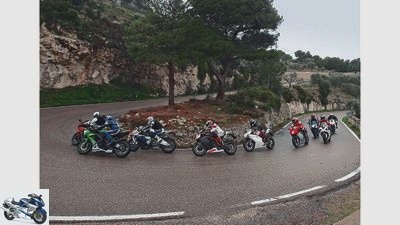
Jahn
21/42
Although the weather in Gargano is actually good all year round, MOTORRAD catches the days when it rains. Since the tires of most super athletes are more suitable for the race track than for rain, the journey through the mountains is a real test for the driver and the machine.
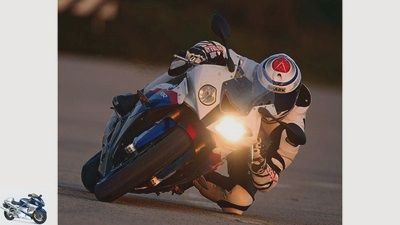
Jahn
22/42
A little Japan, a little asymmetry, lots of plastic and a lot of functionality: the BMW S 1000 RR looks neither new nor original. But very well thought out.
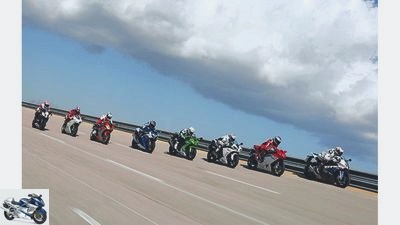
Jahn
23/42
On the high-speed circuit, the super athletes can show what kind of iron they are.
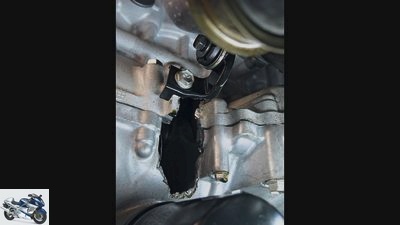
Jahn
24/42
According to Suzuki, the generally poorer gasoline in Italy would also be to blame for the burst engine of the GSX-R 1000. Since the connecting rod that hit the engine housing could no longer be found, however, an exact analysis is not possible.

Jahn
25/42
The MV Agusta F4 also had problems. The gearbox was exchanged, the multiple stalling of the engine was due to a loose battery cable, according to MV. The loss of performance is due to an improperly welded catalytic converter that wandered around in the exhaust and blocked it at times.
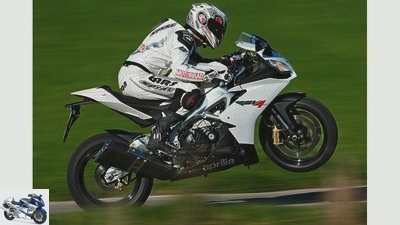
Jahn
26/42
But now to the bikes: The Aprilia RSV4 R was the first in the field.
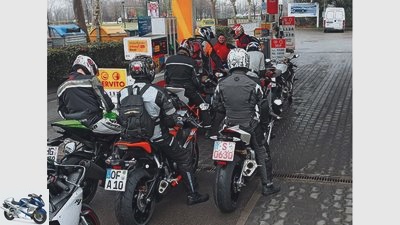
Jahn
27/42
Everyone has to refuel. But you should be careful in Italy, as Super Plus is rarely available at petrol stations. From our own experience, this warning is mainly addressed to all RC8 R owners.

Jahn
28/42
But finally arrived in Nardo, the sun is smiling again and the preparations for the high-speed test can begin.
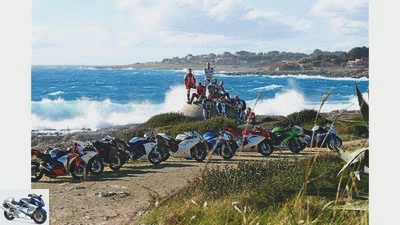
Jahn
29/42
But the way to Nardo was all the more beautiful.
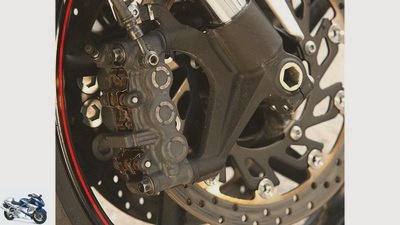
Jahn
30/42
The brakes of the Yamaha YZF-R1 are unfortunately not quite as convincing. An ABS wouldn’t look bad at her.
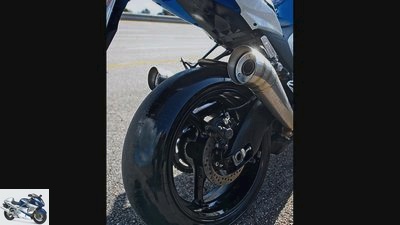
Jahn
31/42
An engine burst generously distributed oil on the rear wheel of the Suzuki GSX-R 1000. At second glance, the exhaust of the test GSX-R 1000 is noticeable: The Yoshimura mufflers help the Suzuki to a significantly better appearance.
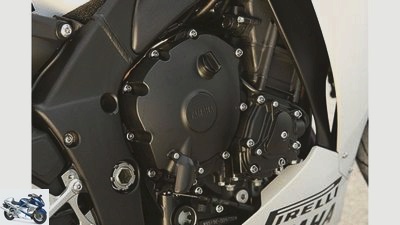
Jahn
32/42
However, the engine of the Yamaha YZF-R1 is impressive. He dresses properly.
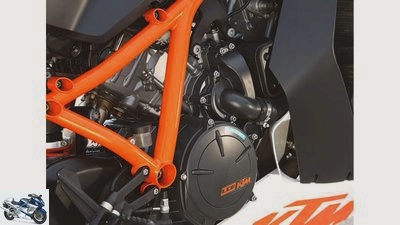
Jahn
33/42
After the old KTM RC8 had already failed twice due to engine damage, the RC8 R had to give up this time due to incorrect fueling. Instead of Super Plus, it only got Super, which the exhaust valves and cylinder heads didn’t like at all.
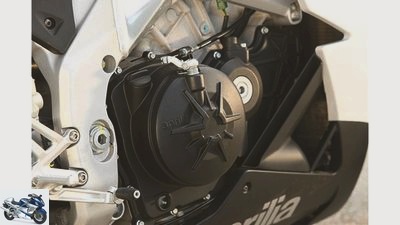
Jahn
34/42
The motor of the Aprilia RSV4 R fits perfectly into the aluminum bridge and enables a tight knee joint and a balanced weight distribution. But after the presentation, Aprilia had problems with the connecting rods and started a recall. Despite the revision, the RSV 4 R still did not make it to the high-speed test because a connecting rod bearing ran in on the way there.

Jahn
35/42
One disadvantage of the Honda Fireblade is the footpegs that are far forward and a little too high. This is a problem for taller drivers in particular.
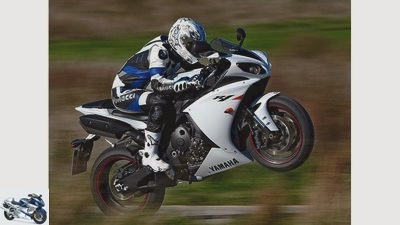
Jahn
36/42
No question about it: Beauty Queens come across as different. But they usually don’t tear like the Yamaha YZF-R1.
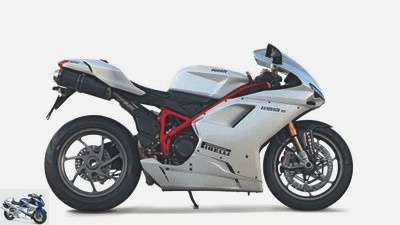
Jahn
37/42
Red frame, white plastic? Wasn’t it the other way around earlier? Regardless, the 1198 is, like so much from Italy, a design classic. Rightly.
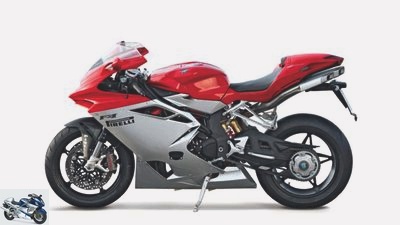
Jahn
38/42
It can look like this: without gimmicks, without experiments. Simply made good even better and remained true to yourself. The MV Agusta F4, born in 2010. Of course in red / silver.
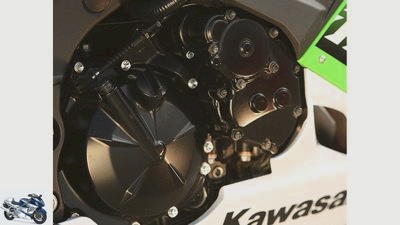
Jahn
39/42
However, the Kawasaki ZX-10R is a real weapon on the racetrack. Thanks to the new Ohlins steering damper, any approach of handlebar twitching is nipped in the bud.
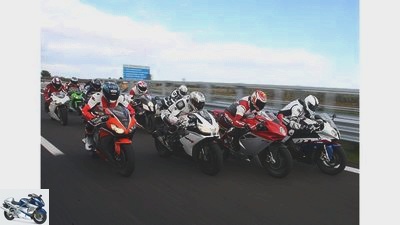
Jahn
40/42
The toughest test for the bikes was clearly the high-speed test in Nardo.

Jahn
41/42
The MV Agusta F4 primarily impresses with its excellent behavior at full load.
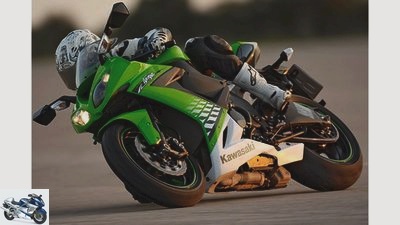
Jahn
42/42
The new exhaust cover helps, the front indicators in the mirror arms certainly do not. In addition, the Kawasaki ZX-10R is one thing above all: inconspicuous.
Comparison test: Superbikes 2010
The final on the racetrack in Spain
The nine superbikes finally meet where they can develop their full potential: on the racetrack. Curtain up on the third and last part of the great comparison.
S.still. There is nothing but silence on this cool morning over the Motorland Aragón circuit. And sun. Finally. The rain, a constant companion on the first two parts of this giant test, cannot be seen at the finale. The pit lane is deserted, yet. A pit gate rumbled up. Behind them the nine superbikes are waiting for the freestyle, all soled with Pirelli Supercorsa SC2. Lap times count now, the performance on the racetrack. What their designers had in mind. Not rearview mirrors, consumption or passenger comfort.
Buy complete article
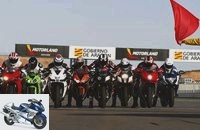
Comparison test: Superbikes 2010
The final on the racetrack in Spain
KTM RC8 R with barking gas bursts to temperature. Meanwhile the red light of the pit lights goes out. Nimble hands unwind the tire warmers, Peter Ottl rolls onto the track. The requirement: three timed laps per man and machine, give everything but not produce scrap. Shortly thereafter, he turned into the home straight for the first time, diagonally as hell, spurring the loudly roaring KTM.
The tightly tuned shock absorber and the crystal-clear feel for the rear wheel enable the driver to cock the cock at the exit of the curve. The KTM-V2 accelerates harshly, but then makes a lot of steam. In conjunction with the short gear ratio, the KTM is a force at the exit of a curve.
archive
1500 kilometers and a temperature difference of around 20 degrees lie between these two images of loading (Stuttgart, left) and unloading in Alcaniz.
However, in connection with the relatively narrow usable speed range, this requires frequent gear changes. It is the only one where Ottl pushes in fifth gear in the long left turn towards braking point B2. The jammed gear, however, stands in the way of quick and time-saving gear changes.
But the KTM impresses with razor-sharp turning, sails exactly where the pilot wants it, and zips through the downhill chicane like a dolphin through the water. The KTM’s braking system is also impressive. With a fabulous bite and finely adjustable, linear effect, it is a guarantee for precise braking maneuvers. However, when you brake hard at the rear, the KTM develops a noticeable life of its own, which takes a bit of the edge when you turn on the brake and costs time. In the end, the KTM recorded 2: 07.64 minutes.
The amateur is even more busy sorting the switching points for the robust, vibrating twin, which takes a good three seconds longer for one cycle. So a good thing for the Ducati 1198 S, right? After all, your twin is the measure of all things in sport. Even if the KTM puts out five more horsepower. But much more important: between 7000 and 10 000 rpm, the Testastretta clearly outperforms the KTM-V2. But even more impressive is the way the Duc-Twin gets down to business.
At the apex of the bend, let the speed spin down to 6000 / min, then pull up the gas boldly. The Ducati pushes forward with brute force. Up to 8000 rpm, the torque increases from just under 60 to 132 Nm, which the driver perceives as a neat kick in the backside and often lets him come out of the curve on the rear wheel.
archive
Meticulous as well as reliable time and data supplier: Ex-GP driver Peter Ottl at work.
Furious brakes are also available to tame the V2 volcano. And of course a traction control that can be adjusted in eight stages, which effectively ironed out overly impetuous actions on the gas and lets the amateur boldly pull on the cable. However, the low-contrast and not particularly easy to read display is not of great help. In order not to be rudely stopped by the limiter, you should always keep an eye on the three-lamp shift light.
So that everything is okay? Not at all. It is true that the Ducati with its stiff tubular space frame is in its element in fast corners – and there are a few of them here. But even now, the unfortunate suspension set-up hails a top result. The fork, which has been tuned too softly, dips deeply when braking hard. And especially here, where a lot of trust in the front wheel is extremely important due to some hanging bends, that is lost when turning on the brake.
This cliff can be avoided with a gentler and rounder driving style – no problem for the former 125cc driver Ottl. The amateur has to struggle with it and hardly builds up a deep trust in the front wheel. When Ottl declined, he still had a respectable 2:07:31 minutes, while the amateur’s fight was reflected in four seconds behind.
The fact that the Ducati also requires the most physical effort when changing direction quickly, despite light forged wheels, underlines what was already indicated on the country road: It is a very intense and stimulating motorcycle, but also strenuous to drive.
The Yamaha YZF-R1, on the other hand, was particularly easy to handle on the country road. But what does that mean on the racetrack, where cornering speed, traction and stability are called for?
But for skeptics, the R1 quickly takes the wind out of the sails. Peter Ottl literally blossoms, although the spring elements are too soft for the very hard pace, which also takes away some of the shine in terms of precision. On the other hand, she throws her fine handling into the balance, strong and stable six-piston stoppers and a relaxed, albeit perhaps a little too relaxed sitting position for gasping.
Above all, however, their unconventionally sparkling row fours are unbridled fun. Hangs great on the gas, pushes motivated from middle positions without running out of breath at high engine speeds. And this beguiling sound. Maybe it will give you extra wings. In any case, you feel at home on the Yamaha right away, and go for the chase. And racing driver Ottl puts a huge gap between the Yamaha and the two-cylinder with 2.06.55.
Comparison test of superbikes: part 2
archive
A start like before. The first sprint goes to the motorcycle instead of the first corner.
Helmet off, a quick sip from the bottle, and he roars out onto the track with the Aprilia RSV4 R. Five laps later. Ottl rolls into the pit lane, takes off his helmet and grins. Wide. "This is a real racing motorcycle". He doesn’t have to say more. 2: 06.33 minutes. Best time. However, only after the almost nervous handiness was cured by clearly readjusting the pressure level of the fork in the direction of hard and the rear height was slightly reduced by adjusting the length of the shock absorber.
By the way, squeezing the engine doesn’t help. For the last 1000 revolutions, the RSV only continues to rotate with the foam braked, and the limiter strikes 500 rpm before the red area. So it’s better to shift at 12500 rpm. But the hammer is the chassis. The unbelievable maneuverability and the razor-sharp turning, the chassis, which is especially tightly tuned at the rear, which gives a lot of feedback and thus confidence for enormous cornering speed, the high, compact seating position, the perfectly working slip clutch: This is the stuff racers are made of. And that more than makes up for things like the rather hard throttle response, the hooking and long shift travel despite the shift lever sitting very close to the detent, or the slippery seat.
In his turn, the amateur cannot convert the agility and the enormous possibilities of cornering speed that the Aprilia has to offer in record lap times. But on the one hand, it is easier for him than almost anyone to achieve good times. On the other hand, he has a lot of fun because of his light-footedness and precision. But what is Aprilia’s time really worth? Because now the BMW S 1000 RR is on the slopes. Power, power and more power, kept in check by a lot of elaborate control electronics, ABS and traction control.
But it would be a mistake to reduce the BMW to just its power and electronics. Because it turns out to be an incredibly strong overall package. Has no trouble threading his way lightly through the tricky downhill chicane and firing just as determinedly as it is precisely through the fast uphill right bend. It’s amazing how the brakes grip, even if the pressure point, which then remains stable, shifts significantly at the beginning. In addition, the chassis is sufficiently tightly tuned so that there is no unrest even in high-speed passages. However, the driver’s spit remains in view of the violence with which the four-cylinder goes to the point from 10,000 rpm. The top speed values speak volumes. But it takes a while until you can actually implement this speed-hungry power.
archive
The calm before the storm. The pit gate is about to rise, then only one thing counts: speed.
"At first there is no longer any braking point", Ottl puffs after his rounds. The BMW does not break the best time with 2: 07.13 minutes, but the amateur hits his fastest lap with it and even comes within one and a half seconds of Ottl’s time. He benefits tremendously from ABS and traction control. Your indicator light never goes out, so trustingly and hard he pulls on the cable in the long downhill left in sector two. Practically nothing can be felt from the control processes. And when you then brake in an inclined position, the ABS is balm for the nerves. No doubt. The amateur has a clear head and benefits greatly from the electronic helpers.
The Honda Fireblade has at least one of them, an ABS, on board. Right from the start, she instills a lot of confidence in her pilot. Pampered him with excellent handling. In addition, the Honda four-cylinder delivers splendid pressure even in mid-range. If the trailer still had a negative impact below 4000 rpm on the country road, this is no longer an issue here.
But thanks to its fabulous balance on the racing track, the chassis, which has already been praised on the country road, makes it easy to sharpen corners, which also encourages the recreational racer to turn the agitator with ease. One bench is ABS, which although its control processes make the fork easily pump when anchoring hardcore, but always gives a safe feeling. If it were up to our professional, then it should allow even more delay. The good-natured chassis gives the hobby racer real wings. Softly tuned, the approaching limit can be seen with clear movements in the hindquarters. With his lap time, the amateur comes very close to his best time with the BMW and even up to a strong second on the professional.
He would like to add something. But what the hobby racer perceives as movement on the rear wheel and thus as his personal limit, Ottl pushes a little further until grip becomes slippery. Ultimately, he lacks the feedback in the limit area for more, so the clock stops at 2: 07.63 minutes.
archive
Done. History in the box and everything remained intact. The test crew has every reason to smile.
It only takes a few laps, then the Kawasaki ZX-10R has cracked that time. With an impressive 2: 06.98 min. In spite of their translation, which is far too long here. Because in tight corners that others take in third gear, the Kawa demands second. Otherwise your speed will hang in the basement, and then not much is possible. However, the green one moves down a gear like hell. The hindquarters are noticeably pumping, but this does not affect the grip. With which the ZX-10 can fully develop its immense power at the exit of a curve. Their stoppers do not mark the absolute top in this top-class field, but they act very confidently. Above all, however, its braking stability is also top notch thanks to the slip clutch, which greatly simplifies late braking. It also scores with a stable chassis. And everything else fits. Handling, seating position, everything is perfect. So the Green, who was hanging on the road in the good midfield, collects point by point and after Nardo also provides a little surprise here. Especially since the hobby racer gets along with it excellently with 2: 09.3 min.
The Suzuki GSX-R 1000 has so far not got beyond a healthy mediocrity. That should change here. But it doesn’t feel like that at first. In terms of handling, the Suzuki does not set any highlights. It also feels really big and wide. In addition, the brake works toothless in the first grip. Not a good start.
The engine, however, brightens the faces again. At the apex of the bend, it accelerates gently, shines with a powerful center and robust revving, which it combines with good running culture. And gear changes are smooth and precise.
The chassis, however, seems to limit the temperament. On the one hand, the tuning turned out to be quite soft, which not only makes the GSX-R look a bit gummy overall. The Big Piston Fork could also provide a little more feedback. Above all, however, the GSX-R likes to take the further curve at the exit of a curve, when firing with a lot of force.
And yet, somehow you get used to the Suzi and her trustworthy chassis. Drives them more and more courageously around the course. Notices that the brake, if it is applied hard enough, decelerates quite strongly. Although the dosability suffers. And then there is still this massive engine. And then it happened. Peter Otttl stamps the time of the Kawasaki with her. And our motivated amateur does the same. Even more: 2: 06.76 means the third fastest time in a very unspectacular way.
Which will certainly not last long, because the MV Agusta F4 is the last to leave. Why last? Very easily. In the morning the electronics switched off the engine again and again while driving. Half a day of screwing and treating all plug connections with contact spray apparently helped. She runs. And how. What a sound.
And how the four-cylinder goes out at the top. But primarily there. It is not the most powerful, which costs time in the many third-gear corners. No matter. If it gets speed, it goes like a prick. Even more fascinating, however, is the stability of the chassis.
Not the handiest chassis, admittedly. But from the entrance to the corner, the MV runs as precisely and stably as the Ducatis once could. In cornering speed she is right at the forefront. And the feedback couldn’t be better. It is a pleasure to pop into the fast left curve at the end of the back straight. If the Suzuki is more of a cozy house slipper, then the MV is a tightly fitting sports shoe. The display, which is as confused as it is difficult to read, is not of great help in chasing times. And the seating position is still clearly MV. Still with a long tank, deep stumps and high rests. Like the Ducati, the MV is a very intense and fascinating, but also demanding motorcycle.
But even she cannot shake the dominance of the Aprilia on the racetrack and the overall victory of the BMW.
Technical specifications




42 photos
Pictures: Comparison test: Superbikes 2010
To home page

Jahn
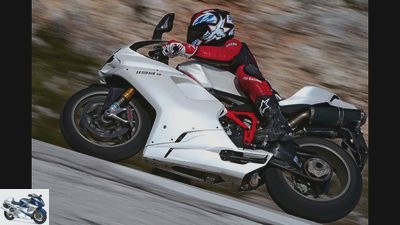
Jahn
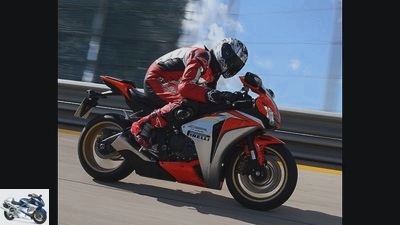
Jahn
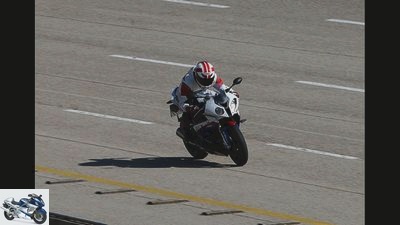
Jahn
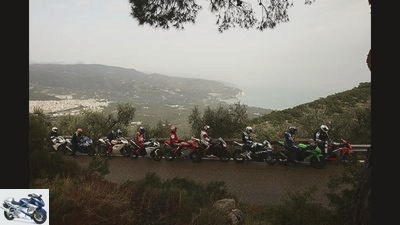
Jahn
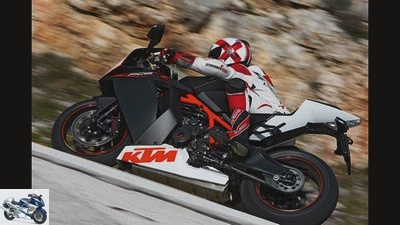
Jahn
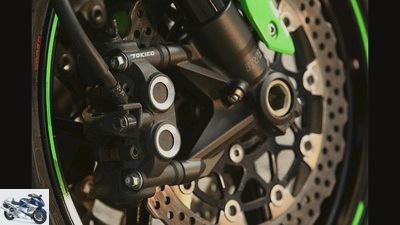
Jahn
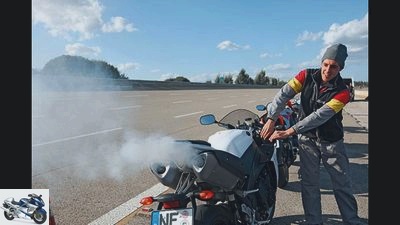
Jahn
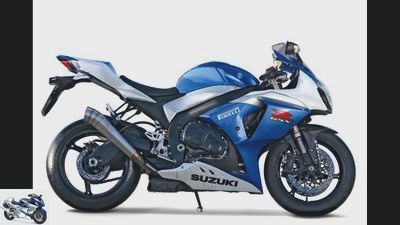
Jahn

Jahn
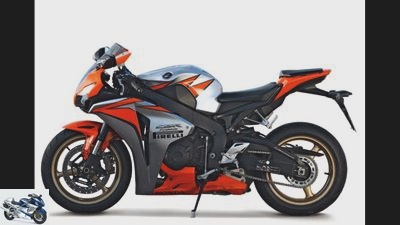
Jahn
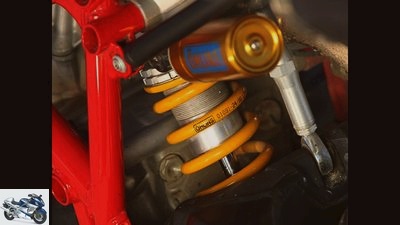
Jahn
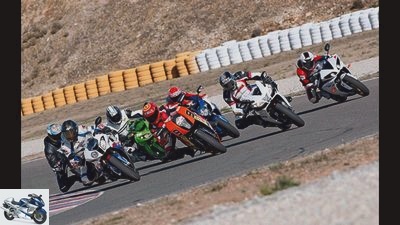
Jahn
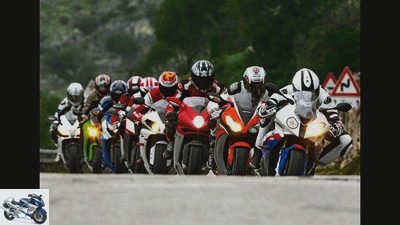
Jahn
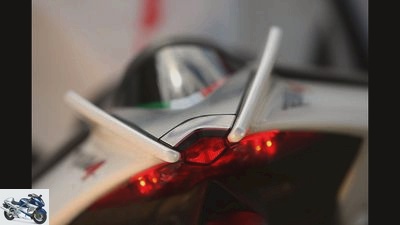
Jahn
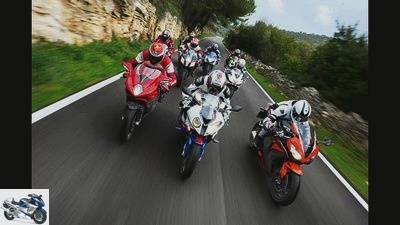
Jahn
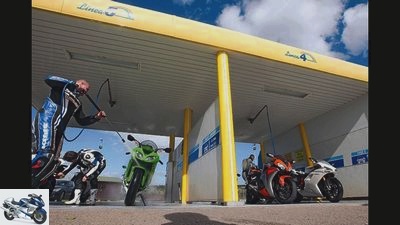
Jahn
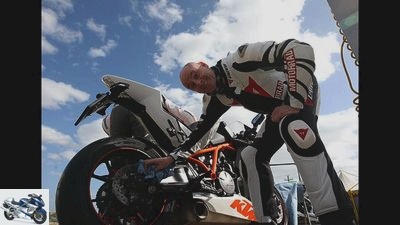
Jahn
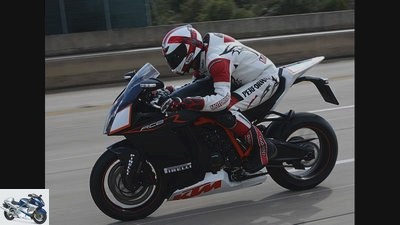
Jahn
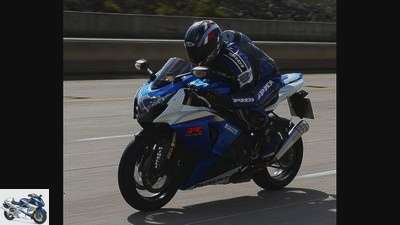
Jahn

Jahn
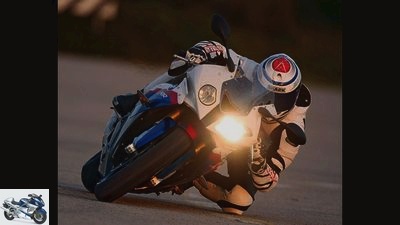
Jahn
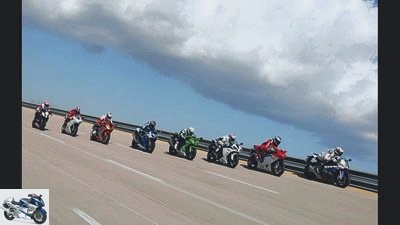
Jahn
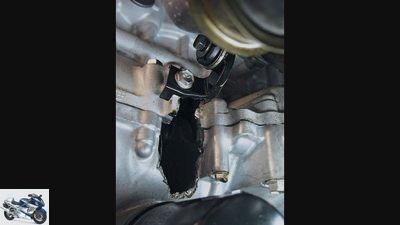
Jahn
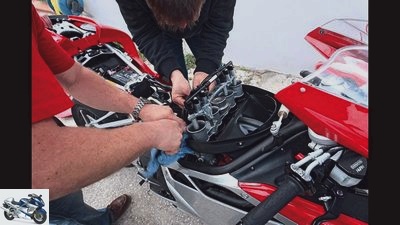
Jahn

Jahn
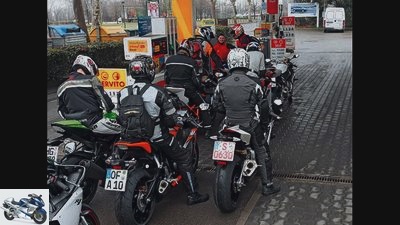
Jahn
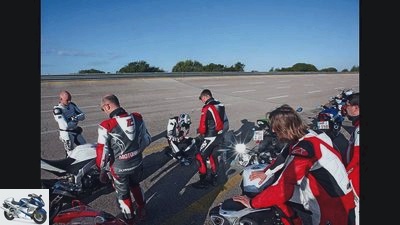
Jahn
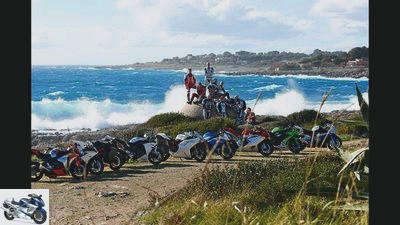
Jahn
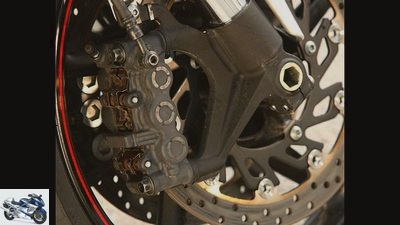
Jahn
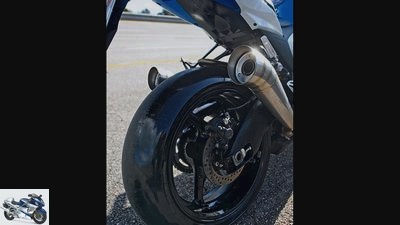
Jahn
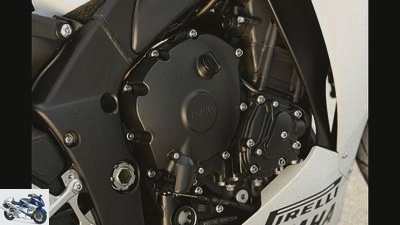
Jahn
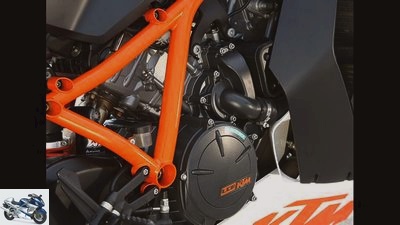
Jahn

Jahn
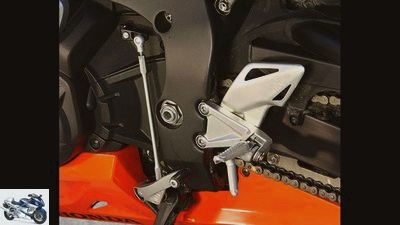
Jahn

Jahn
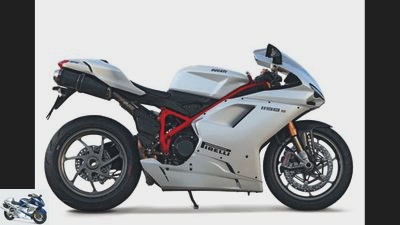
Jahn
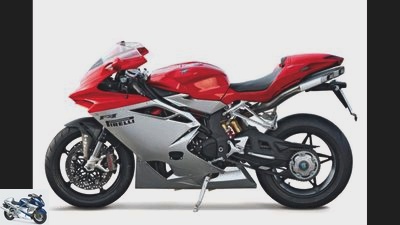
Jahn
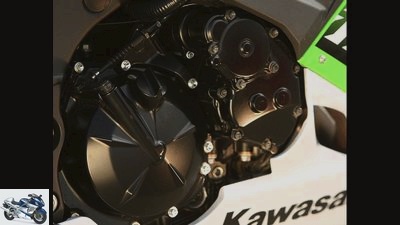
Jahn
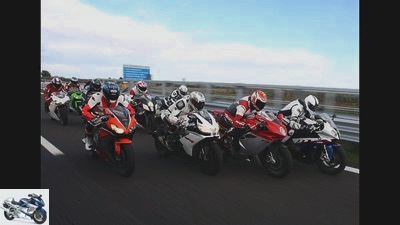
Jahn
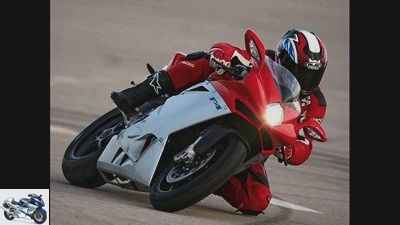
Jahn
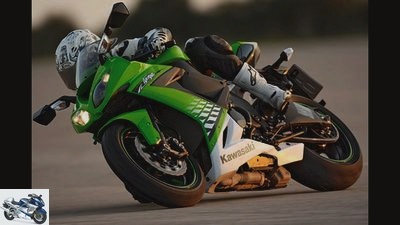
Jahn
Kawasaki ZX-10R
Technical data Kawasaki ZX-10R:
Engine:
Four-cylinder in-line engine
Injection Ø 43 mm
Clutch Multi-disc oil bath clutch (anti-hopping)
Bore x stroke 76.0 x 55.0 mm
Displacement 998 cm3
Compression 12.9: 1
Output 138.0 kW (188 hp) at 12500 rpm
Torque 113 Nm at 8700 rpm
Landing gear:
Frame bridge frame made of aluminum
Fork Upside-down fork, Ø 43 mm
Hydraulic steering damper
Brakes front / rear Ø 310 mm / Ø 220 mm
Assistance systems –
Wheels 3.50 x 17; 6.00 x 17
Tire 120/70 ZR 17 190/55 ZR 17
Pirelli Diablo Corsa III tires front “N”
Mass and weight:
Wheelbase 1415 mm
Steering head angle 64.5 degrees
Trail 110 mm
Front / rear suspension travel 120/125 mm
Tank capacity 17.0 liters
Weight with a full tank 210 kg
Service intervals 6000 km
Price (excluding additional costs) 14,595 euros
MV Agutsa F4 1000
Technical data MV Agusta F4:
Engine:
Four-cylinder in-line engine
Injection Ø 46 mm
Clutch Multi-disc oil bath clutch (anti-hopping)
Bore x stroke 76.0 x 55.0 mm
Displacement 998 cm3
Compression 13.1: 1
Output 137.0 kW (186 hp) at 12900 rpm
Torque 114 Nm at 9500 rpm
Landing gear:
Frame tubular steel frame
Fork Upside-down fork, Ø 50 mm
Hydraulic steering damper
Brakes front / rear Ø 320 mm / Ø 210 mm
Assistance systems traction control
Wheels 3.50 x 17; 6.00 x 17
Tires 120/70 ZR 17 – 190/55 ZR 17
Pirelli Supercorsa SP tires
Mass and weight:
Wheelbase 1430 mm
Steering head angle 66.0 degrees
Trail 100 mm
Front / rear suspension travel 120/120 mm
Tank capacity 17.0 liters
Weight with a full tank 214 kg
Service intervals 6000 km
Price (excluding additional costs) 18,500 euros
KTM RC8 R
Technical data KTM RC8 R:
Engine:
Two cylinder 75 degree V engine
Injection Ø 52 mm
Clutch Multi-plate oil bath clutch
Bore x stroke 105.0 x 69.0 mm
Cubic capacity 1195 cm3
Compression 13.5: 1
Output 125.0 kW (170 hp) at 10250 rpm
Torque 123 Nm at 8000 rpm
Landing gear:
Frame tubular steel frame
Fork Upside-down fork, Ø 43 mm
Hydraulic steering damper
Brakes front / rear Ø 320 mm / Ø 220 mm
Assistance systems –
Wheels 3.50 x 17; 6.00 x 17
Tires 120/70 ZR 17 – 190/55 ZR 17
Pirelli Supercorsa SP tires
Mass and weight:
Wheelbase 1425 mm
Steering head angle 66.7 degrees
Trail 97 mm
Front / rear suspension travel 120/120 mm
Tank capacity 16.5 liters
Weight with a full tank 200 kg
Service intervals 7500 km
Price (excluding additional costs) 17990 euros
Aprilia RSV4 R
Technical data Aprilia RSV4 R:
Engine:
Four cylinder 65 degree V engine
Injection Ø 48 mm
Clutch Multi-disc oil bath clutch (anti-hopping)
Bore x stroke 78.0 x 52.3 mm
Cubic capacity 1000 cm3
Compression 13.0: 1
Output 132.4 kW (180 hp) at 12500 rpm
Torque 115 Nm at 10,000 rpm
Landing gear:
Frame bridge frame made of aluminum
Fork Upside-down fork, Ø 43 mm
Hydraulic steering damper
Brakes front / rear Ø 320 mm / Ø 220 mm
Assistance systems –
Wheels 3.50 x 17; 6.00 x 17
Tires 120/70 ZR 17 – 190/55 ZR 17
Metzeler Racetec K3 Interact tires
Mass and weight:
Wheelbase 1420 mm
Steering head angle 65.5 degrees
Trail 105 mm
Suspension travel front / rear 120/130 mm
Tank capacity 17 liters
Weight with a full tank 212 kg
Service intervals 10000 km
Price (excluding additional costs) 15,364 euros
BMW S 1000 RR
Technical data BMW S 1000 RR:
Engine:
Four-cylinder in-line engine
Injection Ø 48 mm
Clutch Multi-disc oil bath clutch (anti-hopping)
Bore x stroke 80.0 x 49.7 mm
Displacement 999 cm3
Compression 13.0: 1
Output 142.0 kW (193 hp) at 13,000 rpm
Torque 112 Nm at 9750 rpm
Landing gear:
Frame bridge frame made of aluminum
Fork Upside-down fork, Ø 46 mm
Hydraulic steering damper
Brakes front / rear Ø 320 mm / Ø 220 mm
Assistance systems ABS / traction control
Wheels 3.50 x 17; 6.00 x 17
Tires 120/70 ZR 17 – 190/55 ZR 17
Metzeler Racetec K3 Interact tires
Mass and weight:
Wheelbase 1432 mm
Steering head angle 66.1 degrees
Trail 96 mm
Suspension travel front / rear 120/130 mm
Tank capacity 17.5 liters
Weight with a full tank 208 kg
Service intervals 10000 km
Price (excluding additional costs) 15,500 euros
Price of the test motorcycle 17 555 euros (including ABS and DTC for 1220 euros, automatic gearshift for 360 euros and special paint for 475 euros)
Honda Fireblade
Technical data Honda Fireblade:
Engine:
Four-cylinder in-line engine
Injection Ø 46 mm
Clutch Multi-disc oil bath clutch (anti-hopping)
Bore x stroke 76.0 x 55.1 mm
Cubic capacity 1000 cm3
Compression 12.3: 1
Output 130.7 kW (178 hp) at 12,000 rpm
Torque 112 Nm at 8500 rpm
Landing gear:
Frame bridge frame made of aluminum
Fork Upside-down fork, Ø 43 mm
Steering damper electronic / hydraulic
Brakes front / rear Ø 320 mm / Ø 220 mm
ABS assistance systems
Wheels 3.50 x 17; 6.00 x 17
Tires 120/70 ZR 17 – 190/50 ZR 17
Bridgestone BT 015 F tires
Mass and weight:
Wheelbase 1410 mm
Steering head angle 66.8 degrees
Trail 96 mm
Front / rear suspension travel 120/135 mm
Tank capacity 17.7 liters
Weight with a full tank 209 kg
Service intervals 6000 km
Price (excluding additional costs) 14990 euros
Price test motorcycle 15990 euros (including ABS for 1000 euros)
Suzuki GSX-R 1000
Technical data Suzuki GSX-R 1000:
Engine:
Four-cylinder in-line engine
Injection Ø 44 mm
Clutch Multi-disc oil bath clutch (anti-hopping)
Bore x stroke 74.5 x 57.3 mm
Displacement 999 cm3
Compression 12.8: 1
Output 136.0 kW (185 hp) at 12,000 rpm
Torque 117 Nm at 10000 rpm
Landing gear:
Frame bridge frame made of aluminum
Fork Upside-down fork, Ø 43 mm
Steering damper electronic / hydraulic
Brakes front / rear Ø 310 mm / Ø 220 mm
Assistance systems –
Wheels 3.50 x 17; 6.00 x 17
Tires 120/70 ZR 17 – 190/50 ZR 17
Bridgestone BT 016 “N” tires
Mass and weight:
Wheelbase 1405 mm
Steering head angle 66.2 degrees
Trail 98 mm
Suspension travel front / rear 125/130 mm
Tank capacity 17.5 liters
Weight with a full tank 208 kg
Service intervals 6000 km
Price (excluding additional costs) 13990 euros
Price test motorcycle 15,345 euros (including Yoshimura GP EVO IV exhaust system for 1355 euros)
Yamaha YZF-R1
Technical data Yamaha YZF-R1:
Engine:
Four-cylinder in-line engine
Injection Ø 45 mm
Clutch Multi-disc oil bath clutch (anti-hopping)
Bore x stroke 78.0 x 52.2 mm
Displacement 998 cm3
Compression 12.7: 1
Output 133.9 kW (182 hp) at 12500 rpm
Torque 116 Nm at 10,000 rpm
Landing gear:
Frame bridge frame made of aluminum
Fork Upside-down fork, Ø 43 mm
Steering damper electronic / hydraulic
Brakes front / rear Ø 310 mm / Ø 220 mm
Assistance systems –
Wheels 3.50 x 17; 6.00 x 17
Tires 120/70 ZR 17 – 190/55 ZR 17
Michelin Power Pure tires front “A”
Mass and weight:
Wheelbase 1415 mm
Steering head angle 66.0 degrees
Trail 102 mm
Front / rear suspension travel 120/120 mm
Tank capacity 18.0 liters
Weight with a full tank 214 kg
Service intervals 10000 km
Price (excluding additional costs) 15,495 euros
Motorland Aragon / Alcaniz
Drawing: archive
On the slopes of Aragon, athletes have to be prepared for anything.
Spain, you’re better off – at least when it comes to racetracks. They sprout up there like mushrooms. The newest is at Alcaniz, between Barcelona and Zaragoza.
Motorland, the name says it all. On a huge area, the province of Aragón has built a motorsport Eldorado at its finest in just three years. Whether on- or off-road, from karting to MotoGP, anything goes. The circuit, built by the racetrack architect Hermann Tilke, does not have to hide behind the famous Portimão circuit in terms of technical demands and diversity.
The 5077 meter long route with 50 meters difference in altitude offers everything from slow, tricky chicanes to demanding speed curves to hearty full throttle pieces. The MotoGP run planned for the Balaton Ring will take place here on September 19th.
If there was any need to prove the power of the BMW: its top speed values speak volumes. At the end of section two, the advantage of traction control becomes apparent. In sections three and four, the sluggish, soft, not very precise chassis of the Suzuki has a negative impact, while KTM and Aprilia shine there.
| Lap time Professional (min) |
Lap time Amateur (min) |
Vmax (1) (km / h) |
Vmax (2) (km / h) |
Vmax (3) (km / h) |
Vmax (4) (km / h) |
|
| Aprilia |
2.06.33 | 2.09.90 | 236 | 132 | 226 | 277 | BMW | 2.07.13 | 2.08.61 | 247 | 132 | 229 | 286 |
| Ducati | 2.07.13 | 2.11.29 | 234 | 130 | 219 | 266 | Honda | 2.07.31 | 2.08.72 | 235 | 135 | 219 | 271 |
| Kawasaki | 2.06.98 | 2.09.38 | 235 | 133 | 220 | 272 | KTM | 2.07.64 | 2.10.55 | 230 | 130 | 219 | 267 |
| MV Agusta |
2.07.28 | 2.09.81 | 234 | 135 | 217 | 271 | Suzuki | 2.06.76 | 2.09.00 | 240 | 132 | 220 | 272 |
| Yamaha | 2.06.55 | 2.09.72 | 235 | 132 | 222 | 274 |
| Section 1 (sec) | Section 2 (sec) | Section 3 (sec) | Section 4 (sec) | |
| Aprilia | 30.93 | 17.10 | 23.99 | 12.44 | BMW | 31.10 | 16.12 | 24.06 | 12.47 |
| Ducati | 30.75 | 17.18 | 24.14 | 12.58 | Honda | 30.98 | 17.28 | 23.97 | 12.71 |
| Kawasaki | 30.89 | 17.41 | 23.79 | 12.70 | KTM | 31.14 | 17.10 | 23.70 | 12.72 |
| MV Agusta |
30.97 | 17.18 | 24.37 | 12.51 | Suzuki | 32.63 | 15.47 | 25.01 | 13.15 |
| Yamaha | 30.82 | 17.29 | 24.09 | 12.53 |
MOTORCYCLE measurements
Drawing: archive
Power on the crankshaft. Measurements on Dynojet roller test stand 250, corrected according to 95/1 / EG, maximum possible deviation ± 5%
Pretty aloof. How the BMW curve outperforms the other four-cylinder engines from 10,000 rpm is simply awesome. While all other four-cylinder engines lag behind the factory specifications, the BMW even surpasses theirs. Just like the two two-cylinder units, which do not spoil when it comes to top performance. Above all, the 175 hp of the KTM twin are gigantic for a two-cylinder. The rapid increase in torque of the Ducati between 6000 and 8000 rpm ensures that extra kick at the corner exit. While the Honda was scolded on the country road for its torque trailer below 4000 rpm, its nice, voluminous performance curve fits here in the middle range. Just like the Suzuki, it offers a nice performance plateau at high engine speeds and thus reserves to save one or the other gear change before cornering. In contrast, the performance curve of the Aprilia RSV4 R, which, unlike the RSV4 Factory, has to do without variable intake trumpets, soon drops off steeply. Here, shifting gears early on the track helps more than just turning the corner.
The tires for the test
archive
The right rubber makes driving at the limit possible.
When dancing on the last groove and inclines over 50 degrees, production tires have a break, then super glue is required. For this test, all machines were equipped with Pirelli Supercorsa SC2. After the test and calibration runs, all nine had fresh tires fitted. They were driven for four laps before the time trial. The Pirelli impressed across the board with a good grip, powerful taker qualities when braking in an inclined position and problem-free border areas. The front and rear were driven with an air pressure of 2.3 bar.
MOTORCYCLE test result
They were all ready to start, but only one could win.
1st place: BMW S 1000 RR
It did not achieve the absolute fastest time, but as in the first two parts, the BMW scores across the board with solid qualities.
2nd place: Aprilia RSV4 R
So what. Here she can really let off steam, combining unbelievable driving fun with the absolute fastest time. Only electronic helpers are missing to win the points.
3rd place: Honda Fireblade
Its balance helps the Honda not only to achieve decent lap times, but also to third place, even though it is only average in terms of chassis set-up.
4th place: Yamaha YZF-R1
The Yamaha finished third, tied on points with the Honda, thanks to the great engine and the handy chassis. If it had ABS or traction control now…
5th place: MV Agusta F4
The engine comes out on top like hell. And the rock solid chassis is the highlight of the MV. With better handling and a more comfortable seating position, more would have been possible.
5th place: Kawasaki ZX-10R
The green collects a lot of sympathy points on the route. Thanks to the stable brakes and the revving engine, it lands in the solid midfield. But it is not enough for more.
7th place: KTM RC8 R
It is handy, precise and blessed with a very stable chassis and great brakes. The fiery V2, however, demands a hard-working gearshift.
8th place: Ducati 1198 S.
An engine like a volcano with incredible pressure. However, you have to know how to use the chassis to be happy with it on the slopes. What the professional can still achieve halfway.
9th place: Suzuki GSX-R 1000
The Suzuki cannot convince in terms of handling, cornering stability, braking or precision, but its lap time is respectable. However, this does not spare you the last place.
Related articles
-
Comparison test of the 1000 super sports car, part 1
Jahn Comparison test of the 1000 super sports car, part 1 The full program Lean, strong, ready for attack, the Suzuki GSX-R 1000 completes the field of…
-
Comparison test: Germany is looking for the superbike
Jahn 42 photos Jahn 1/42 Top handling and transparent feedback are what make the BMW S 1000 RR. It also owes a lot to the electronic tools. Jahn 2/42…
-
Comparison test: seven enduro bikes in Sweden
Jahn 28 photos Jahn 1/28 The operation of the Multistrada has also changed: a control center for electronics and motor directly on the handlebars. Jahn…
-
Comparison test KTM 990 Supermoto versus Ducati Hypermotard 1100
Mayer Comparison test KTM 990 Supermoto versus Ducati Hypermotard 1100 Supermoto duel Sharp edges or curved lines: with the Hypermotard 1100 and the 990…
-
Comparison test: high-speed test in Nardo
Jahn 42 photos Jahn 1/42 Top handling and transparent feedback are what make the BMW S 1000 RR. It also owes a lot to the electronic tools. Jahn 2/42…
-
Comparison test: touring motorcycles
fact 39 pictures fact 1/39 But now to the tourer bikes. The entry-level is the BMW R 1200 RT, which despite its mediocre engine with high-quality equipment, …
-
BMW, Ducati, Suzuki and Triumph super sports cars in a comparison test
29 photos 1/29 Triumph Daytona 675, Ducati 848 Evo Corse SE, BMW S 1000 RR, Suzuki GSX-R 750. Different bikes – different cubic…
-
Test of the Superbikes 2012 – The super athletes on the racetrack
Jahn 26th photos Jahn 1/26 The super athletes: Aprilia RSV4 Factory APRC, BMW S 1000 RR, Ducati 1199 Panigale S, Honda Fireblade, Kawasaki Ninja ZX-10R,…
-
Honda Fireblade vs. Suzuki GSX-R 1000 in comparison test
Maccabelli The last four-cylinder without control electronics Test: Honda Fireblade against Suzuki GSX-R 1000 Content of They are the last current…
-
Honda Crossrunner and Suzuki V-Strom 1000 in comparison test
fact 30th photos markus-jahn.com 1/30 Honda Crossrunner and Suzuki V-Strom 1000 in comparison test. markus-jahn.com 2/30 Honda Crossrunner and Suzuki…